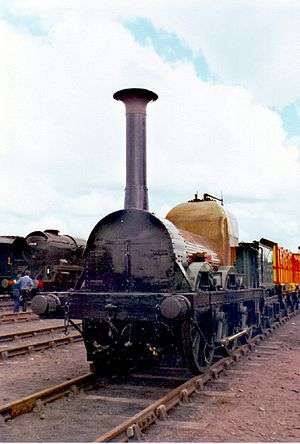LMR 57 Lion
|
LMR 57 Lion | |||||||||||||||
| |||||||||||||||
| |||||||||||||||
| |||||||||||||||
| |||||||||||||||
The Liverpool and Manchester Railway (LMR) 57 Lion is an early 0-4-2 steam locomotive, which had a top speed of 45 mph (72 km/h) and could pull up to 200 tons (203 tonnes).[2] One of a pair designed for hauling freight (the other, number 58 was called Tiger), built by Todd, Kitson & Laird (later Kitsons) of Leeds in 1838. It was also used in the 1952 film "The Titfield Thunderbolt."
History
In 1845 the LMR was absorbed by the Grand Junction Railway (GJR), which in turn was one of the constituents of the London and North Western Railway (LNWR) a year later. Lion received a new boiler about 1845. It was used in traffic until about 1858, and in 1859 it was sold to the Mersey Docks and Harbour Board for use as a stationary engine. It was used in that role until 1928 when it was replaced by an electric pump. It was then "rediscovered", renovated and displayed in the Transport Gallery of the Liverpool Museum. Lion's tender had long since been scrapped so one from an early Furness Railway locomotive was restored to run with her.
Lion took part in the LMR centenary celebrations in 1930 and the London and Birmingham Railway centenary in 1938. It starred in the 1953 film The Titfield Thunderbolt, among others. During the filming of 'Thunderbolt' the tender was damaged in a shunting accident, the damage still being visible. It is the second oldest locomotive to be steamed, the older being the British-built American locomotive John Bull. For many years, Lion was on display at the Museum of Science and Industry in Manchester alongside replica Liverpool and Manchester Railway locomotive Planet.
On 27 February 2007, Lion was moved by road from Manchester to Liverpool for conservation work prior to it taking pride of place in the new Museum of Liverpool.[3]
Other locomotives
London, Midland and Scottish Railway Royal Scot Class 4-6-0 locomotive 6142 was originally named Lion. This loco was built by the North British Locomotive Company at Glasgow in November 1927 and withdrawn in January 1964 as 46142 The York and Lancaster Regiment.
D0260, a prototype diesel locomotive built by Birmingham Railway Carriage and Wagon Company in 1962 was named Lion.
British Rail Class 08 diesel shunter 13030 (later D3030 then 08022) was sold to Guinness at Park Royal in 1985 where it was given the name 'Lion'. It and its sister locomotive 'Unicorn' now reside on the Cholsey and Wallingford Railway.
See also
References
- ↑ Casserley, H.C. (1960). Historic locomotive pocket book. London: Batsford. pp. 9–10.
- ↑ Tufnell, Robert (1986). The Illustrated Encyclopedia of Railway Locomotives. Chartwell Books, Inc. ISBN 9781555210861.
- ↑ "Train leaves city - by road!". Manchester Evening News. 27 February 2007. Retrieved 2007-02-28.
Further reading
- Bailey, Michael R. (2014). "The Patentee Type: Lion 0-4-2". Loco Motion. The History Press. pp. 120–122. ISBN 978-0-7524-9101-1.
- Reed, C.W. (June 1953), "Resurrection of the old Lion", Railway World
- Reed, C.W. (1957), "The iron 'Lion': Locomotive, pump engine, film star", Journal of the Stephenson Locomotive Society, 33, 312
| Wikimedia Commons has media related to Lion (locomotive). |
External links
- http://www.southernsteamtrains.com/alion.htm (see subpages)
- http://www.lnwrs.org.uk/GoodsLocos/ex001P.php photograph
- http://hex.oucs.ox.ac.uk/~rejs/photos/A40/Manchester/MSIM/ more photos (scroll down)
- http://www.lionlocomotive.org.uk/ The website of The Old Locomotive Committee (OLCO)
